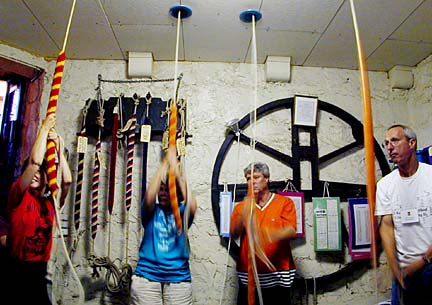Advertisement - Click to support our sponsors.


For whom the Anyone spending time in downtown Honolulu tomorrow is likely to hear bells ringing ... and ringing and ringing.
bells toll: Ringers
at St. Andrew’s
A 400-year-old form of
music will be played using
the cathedral's tower bellsBy Mary Adamski
Star-BulletinIt's not a wedding or a warning, just conventioneers letting loose at their noisiest. As the finale of a four-day convention, members of the North American Guild of Change Ringers will take turns at the ropes of St. Andrew's Cathedral's eight tower bells to perform a 400-year-old form of music.
The 100 guild members -- gathered from the mainland, Canada and as far away as Great Britain -- have been practicing their craft since Wednesday with the bell clappers "tied" and the tower roof hatches closed in deference to residents and workers in surrounding buildings.
"We try to be good neighbors, but on the Lord's Day, we feel we can make a lot of joyous noise," said Robert Verrey, leader of the cathedral bell ringers. "I want everyone to have a chance to play when it's open."
The pealing will go on for about 45 minutes after both the 8 a.m. and 10 a.m. services and from 2 to 5 p.m.
What people will hear is not the medley of familiar hymns that broadcasts forth from many church towers. Those bells are carillons or chimes on which only the clapper moves and which one person controls from a keyboard. Nowadays, it's more likely a recorded performance than a live performance.
Guild President Bruce Butler of Philadelphia describes change ringing as "a discipline that stimulates the intellect and engages you physically."
At a Wednesday session, he stood in a circle with seven others in a room 50 steps up the church tower. Each ringer grasped a "sally," a woven woolen padding over the bell rope, and took turns giving a controlled yank.
Overhead in the top chamber of the tower, which houses eight bells ranging from 595 pounds to 1,370 pounds, each yank set a bell rotating. Each bell is bolted into a circular wheel-like frame that does a 360-degree revolution with each tug.
The tug takes strength but it's not a test of muscle power. Some change ringers are women or teen-agers. "The muscle is provided by the weight of the bell," said Verrey.
Butler said an observer might see the circle of rope pullers, obviously concentrating but clearly enjoying themselves, and assume he could just step in. "It'd be like watching a racing cyclist and assume you could sit on your bike and do the same."
He said the greatest challenge is intellectual. Ever since the change-ringing music form was developed in the 1600s, ringers have learned to play compositions known as methods, which may go on for three hours without ever repeating the same sequence of notes.
Each method is named and produces a rhythmic, harmonic pattern of sounds and pauses different from any other. This week they were playing everything from "Grandsire Method" which is 300 years old to "Titanic Cinque," one of the new generation of computer-produced mathematical combinations.
To learn his part, a change ringer must memorize a list of numbers showing his precise place in each 8-bell sequence. A round of changes from the highest pitch to the tenor low is denoted as 12345678. From there, the person on Number 4 bell may next play first in the sequence, then third, then fifth, then eighth, and so on through as many as 40,320 changes without a repeat.
Prospective listeners tomorrow needn't worry about being taxed with anything that complex. "We'll be doing a quarter peal," said Verrey. "It's about 1,200 changes and it takes 45 minutes."
Probably because of its English roots, change ringing is most likely to be used in Episcopal churches, said Butler, but it is also heard in secular towers such as the University of Chicago and the Old Post Office in Washington, D.C. St. Andrew's is among only 40 change bells towers in the United States and Canada.
Butler and his wife, Eileen, ring bells at two Philadelphia churches. He's a walking history of the art form, quick with dates and numbers.
Paul Revere was a change ringer, he said, and "That's why he had access to the Old North Church where the signal lanterns were hung" when the British were coming.
For those who listen with an ear to detect error, "a big mistake would be two bells rung at the same time," Verrey said. "The key is timing" and if that goes awry, the circle of bell ringers will halt operations.
"There's a lot of unknowns -- a rope could break, a clapper come loose. If it was a given, it wouldn't be as much fun," Verrey said. "That's why we call it a quarter peel attempt. It's not a guaranteed finish."